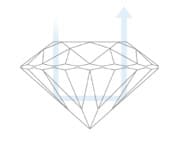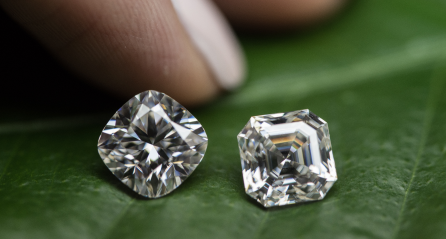Diamond Cut
On this page you will find :
- Diamond cuts explained
- Diamond cuts : grading
- Polish and symmetry explained
- How our diamond selection makes your decision easier
- A video by GIA explaining the diamond cut
- Further diamond education
Diamond cut
Cut does not only refer to the shape of the diamond but also to the proportions, symmetry, and polish of the diamond.
While the other 4 c's - carat, color, clarity affect the diamonds overall value, it is the diamond cut that determines the stone's facets, proportions and its ability to reflect light. An expertly cut diamond will have a high brilliance or sparkle. Even if the other characteristics are near perfect a poor cut can result in a dull, shineless diamond. The beauty of a diamond depends more on cut than on any other factor.
The diamond cut has three primary effects on the appearance of the diamond:
- Brilliance or brightness of the diamond
- Fire or the dispersion of the light into colors
- Sparkle when the diamond is moved.
The factors that affect the price of the diamond are:
- Proportions (table ,widht and depth)
- Symmetrical facets (the windows, mirrors and diamond steps)
- Sparkle when the diamond is moved.
- Scintillation ( how the diamond flashes when it moves)
- Finishing of the diamond ( polishing and permanent treatment)
- Brilliance (how bright is the light that is reflected)
When light shines on a diamond approximately 20% immediately reflects off the surface. The rest of the light enters the diamond and depending on the cut is reflected back to the surface and creates the brilliance, fire or sparkle. A diamond that is well proportioned will have every facet correctly angled and placed so that a maximum amount of light is reflected back via the top of the diamond. With poorly cut diamonds the light leaves the diamond at the bottom where it cannot be seen.
Examples of poorly cut diamonds


If the diamond has a shallow cut, the light that enters hits the pavilion at a low angle and escaped the diamond through the bottom
If the diamond has a deep cut, the light will hit in a way that it hits the first and second pavilion facet, but the second one at an angle too low to reflect correctly and thus the light escapes again through the bottom


If the diamond has a shallow cut, the light that enters hits the pavilion at a low angle and escaped the diamond through the bottom
If the diamond has a deep cut, the light will hit in a way that it hits the first and second pavilion facet, but the second one at an angle too low to reflect correctly and thus the light escapes again through the bottom
Example of a well-cut diamond


In a well-cut diamond, each pavilion is hit by the light at an angle that will result in most of the light being reflected back through the top of the diamond. This is often viewed as "fire" within the diamond.
When diamonds are cut there is a high pressure to maintain as much carat weight from the rough stone as possible. Appearance is often sacrificed for weight. This comes from the fact that many people who are looking to buy a diamond prefer a stone that looks bigger. This is why the cut grade is important as it allows the buyer to identify the stones that were cut fair to poor to preserve or even gain carat weight.
In reality, a little over 50% of all round diamonds receive an excellent cut grade. That is why we recommend to further look for diamonds with excellent proportions, symmetry and polish so you don't end up with a mediocre "excellent" cut diamond.
Diamond cut grade
The "Cut" of the "4-Cs" is the most difficult part for a customer to judge when selecting a good diamond. This is because some certificates will not show the critical measurements influencing cut (such as the pavilion angle and crown angle) and will not provide a subjective ranking of how good the cut was. The other 3-Cs can be ranked simply by the rating in each category. Below you will find the different ratings used to determine the different types of diamond cuts.
- Excellent The best diamond cut. Maximum fire and brilliance. Reflects nearly all of the light that enters the diamond, creating exceptional sparkle and life.
- Very Good Properly reflects most of the light that enters the diamond, producing superior fire and brilliance. Under normal lighting conditions, appears very similar to Excellent Cut, but for a lower price.
- Good Reflects a majority of the light that enters the diamond, for an above average appearance. An excellent value compared to higher cut grades.
- Fair Allows much of the light entering the diamond to escape from the sides or bottom, reducing perceived fire and brilliance. More acceptable in diamonds of less than .75 carats, where differences in sparkle are more difficult to perceive.
- Poor Allows most of the light entering the diamond to escape from the sides or bottom. The diamond may appear noticeably dull and lifeless, even to an untrained eye.
Diamond cut : Polish and symmetry
Polish and symmetry are two important aspects of the diamond cut. The polish describes the smoothness of the diamond's facets, and the symmetry refers to alignment of the facets. With poor polish, the surface of a facet can become dull, and may create blurred or dulled sparkle. It may also constantly look like it needs to be cleaned. With poor symmetry, light can be misdirected as it enters and exits the diamond.
How our selection makes your choice easier
We have chosen to preselect and offer only round diamonds on our site with a grade of very good or better. This way you are sure that whatever diamond you select you will always have one that has the optimum brilliance and sparkle. If you do decide to buy any other shape we recommend you to see a high quality image of the diamond or to inspect it visually if possible.
The bottom line
While carat determines the weight of your diamond it is actually the cut that will determine the size of the diamond.
Diamond cut : our advice to find a high quality diamond
We at Antwerpdiamonds.direct recommend only Very Good and Excellent Cut stones. These parameters will ensure that your Diamond has an optimal Brilliance and Sparkle. Furthermore, we advise you to also select a diamond with excellent proportions, symmetry, and polish. These diamonds will have a premium price but you will be assured you are buying a diamond with maximum beauty and quality. Our advise is to spend a bit more on cut and less on the other 4c's to get the most value for your money.
If however, you feel that this parameter is not so important to you, we can always offer you 'lesser' cut diamonds at more interesting prices. Feel free to contact us for a custom offer.
If you need any help finding the right diamond , we are happy to filter together with you and make recommendations based on your preferences and budget








